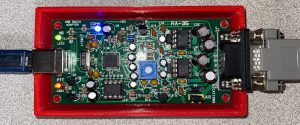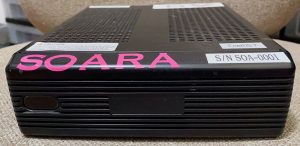Echolink allows Ham radio operators to communicate over the Internet via Echolink enabled repeaters, simplex nodes, and cellphone based client applications.
SOARA’s Temple Hill 147.645 repeater has EchoLink capability. The node number is 177360 (K6SOA-L). The node is powered by the SvxLink voice service application on a Mini-ITX Debian Linux system and is interfaced to the repeater controller through a CMedia Audio device.
From the developer of svxLink: “The SvxLink Server is a general purpose voice services system, which when connected to a transceiver, can act as both an advanced repeater system and can also operate on a simplex channel. One could call it a radio operating system.”
Note, due to the callsign limitation of EchoLink, we are using a “Link” designator for our Laguna Beach Temple Hill site. For more information on the DTMF commands used to control Echolink, refer to the SOARA Membership Handbook.
For more information, visit www.echolink.org where you can register your call sign and find more information.
For more information on SvxLink, including how you can build your own Echolink enabled node, visit: svxlink.org
The OpenRepeater project is based on SvxLink and provides a Web GUI based implementation for configuration and monitoring of a simplex node, or full duplex repeater system.
Many years ago, Brian and Howard gave a talk about EchoLink. The slides are available here: NJ6N’s EchoLink Presentation to SOARA August 18, 2003 (PDF) Echolink has changed very little in 20 years except for gaining additional users.
EchoLink clients are available for iOS, Android, Windows, Linux, and MacOS.
Firewall Considerations
If you have a firewall between your computer and the internet (e.g. a Linksys router) then you need to open up ports 5198 thru 5200 for port forwarding. Details can be found at: http://www.echolink.org/firewall_solutions.htm.
If you don’t open these ports, you will get a timeout when you try to connect.
An alternative to configuring your local router for port forwarding, you may also use a public proxy server that handles the port forwarding for you. Public Proxy servers can be found here: http://www.echolink.org/proxylist.jsp
Subscribe to or browse the archives for the EchoLink discussion group
SomeOperating Tips
- Refer to the SOARA Membership Manual for codes needed to use EchoLink
-
Listen first – if you hear someone connect to us – give them a call !
- Don’t forget to ID before you start sending control codes to the repeater.
-
Check the Echolink status – the system may already be connected.
-
When you first connect to a distant node, listen before you start talking -there may be a QSO in progress at the other end.
-
Announce your call and your location – E.G. This is K6XXX in Laguna Beach, California connected through K6SOA, San Clemente.
-
The repeater timer is still 3 minutes – keep you over shorter than the timer.
-
Wait for the repeater to completely drop before transmitting. The Echolink timer is 2 3/4 minutes so Echolink cannot time out the repeater. You must however, allow the repeater to fully drop or you will only get the change from the previous guy’s timer.
-
The system can still be timed out if there are multiple stations connected to it via the internet, they do not leave long breaks and they keep the system busy for more than 2 3/4 minutes. If this happens, you just have to wait for them to leave a pause or for one of the SOARA sysops to disconnect them.
-
Once you’ve finished your QSO, leave a pause in case anyone at either end wants to use the link. E.G. This is K6XXX standing by for anyone else who would like to use the link before we disconnect.
-
If there are no takers, disconnect.
If you have any questions, suggestions or comments about the system, contact the SOARA Elmers’s email list: elmers at soara dot org.
[Page Last Modified: 2021-09-25 nj6n]


